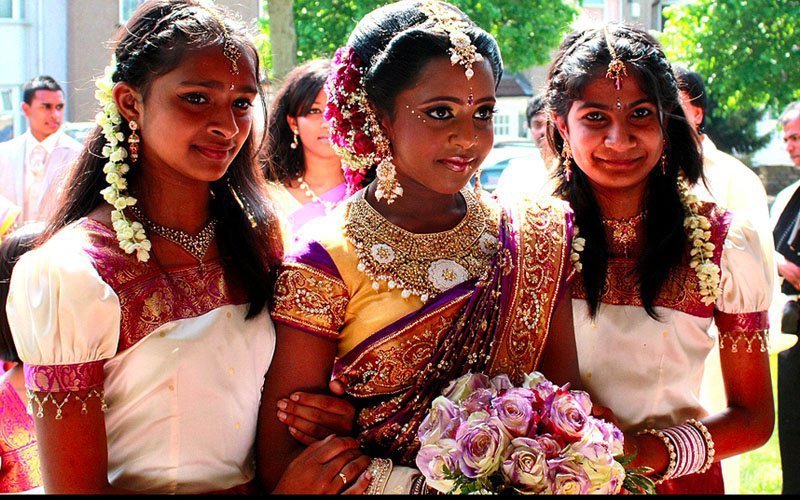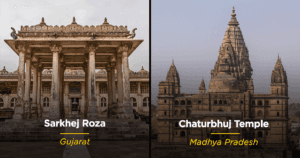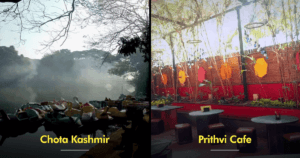India is like a storybook, full of strange and wonderful stories. You may not believe what you read, you may not agree with what’s written, but one thing is for certain. You just can’t stop reading. Because, the more you read, the more fascinating it gets.
Many a time, we Indians choose our hearts over our heads. Holding tight all that we believe in, we confidently tread beyond the realm of rational thinking. These celebrations and rituals will raise many questions, but then, not all questions have answers.
1. Kill or get killed – Bani Festival, Andhra Pradesh
Celebrations are a way of human life. But some are so strange, it questions the very definition of the concept. The Bani Festival celebrated at the Devaragattu Temple in the Kurnool district of Andhra Pradesh illustrates the point. Every Dusshera, hundreds of lathi -wielding devotees from Andhra and Karnataka gather at this temple to hit each each other on the heads at midnight! Drenched in blood, these men go on with the celebration till the beak of dawn, to commemorate the killing of a demon by Mala-Malleshwara (Shiva). According to the temple priest, this festival has been celebrated for over a 100 years, and earlier axes and spears were used instead of lathis ! This year, 56 people were injured during Bani. Medical attendants and policemen are deployed during this festival but they mostly remain spectators, in the face of the the extreme frenzy.
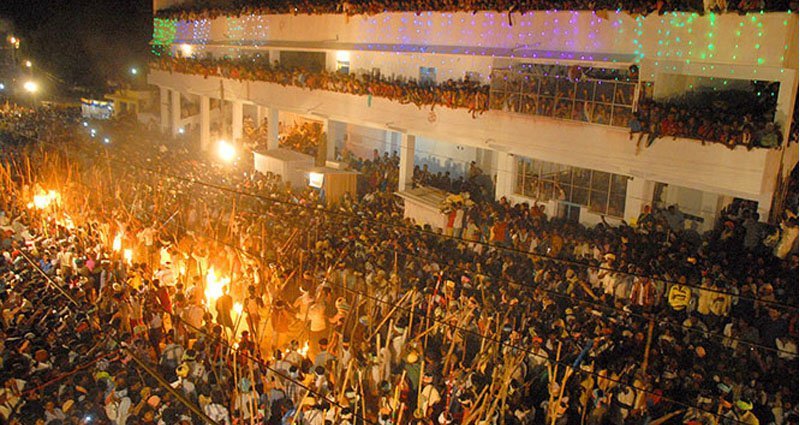
2. Festival of the Snake – Nag Panchami
India shares a very old bond with snakes. These frightening beings have played a prominent role throughout Indian mythology and folklore. India is known to many still, as the Land Of Snake Charmers. Till date, the fifth day of the lunar month of Shravan is celebrated as Nag Panchami across India and Nepal. Live Cobras, without their venomous fangs removed, are worshipped! Priests sprinkle haldi-kumkum and flower petals on their raised hoods. Devotees feed them milk and even rats. It is popularly believed that snakes do not bite on Nag Panchami .
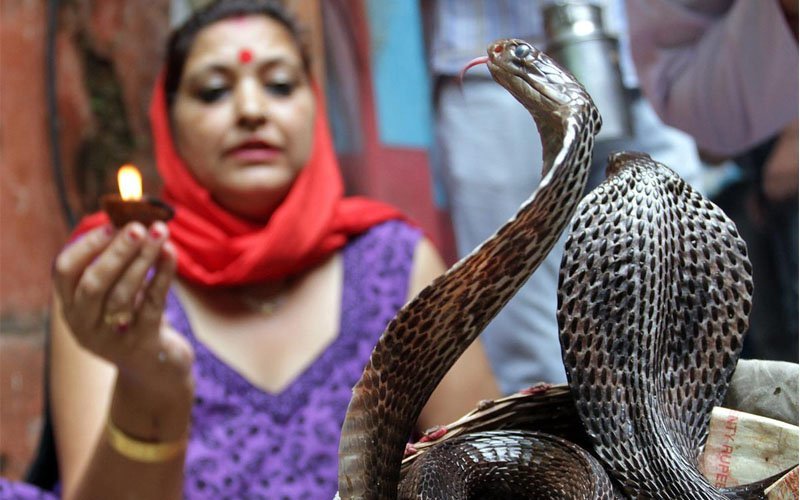
3. Play of the Tiger – Puli Kali, Kerala
Puli Kali, celebrated mainly in Thrissur dictrict of Kerala is one colourful spectacle bursting with energy. Performed by trained artists, Puli Kali is celebrated on the fourth day of Onam. Painted in bright yellow, red and black, performers take to the street, dancing to traditional folk beats. Every year, thousands of people gather to watch this unbelievable sight.
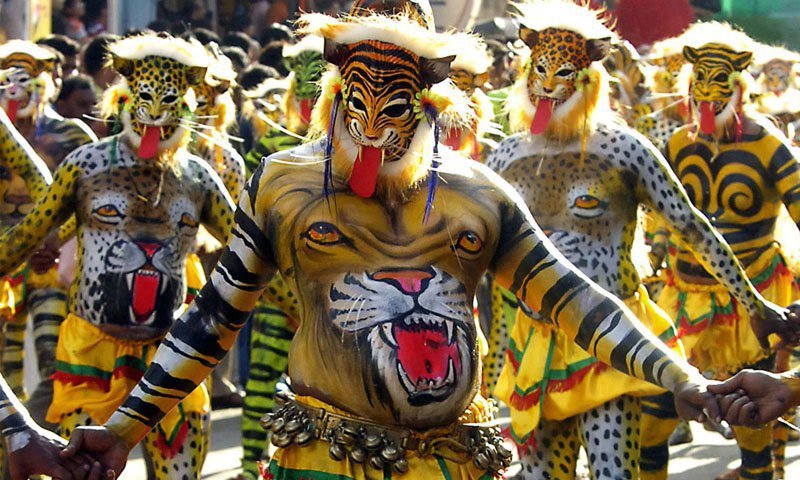
4. Pushkar Camel Fair – Pushkar, Rajasthan
Held every November at the time of the Kartik Purnima full moon, the Pushkar Camel Fair is a particularly spectacular sight to behold. For five days, over 50,000 camels are shaved, dressed up, paraded, entered into beauty contests and races, and traded. Add to that an array of musicians, dancers, acrobats, magicians and snake charmers to entertain the crowd!
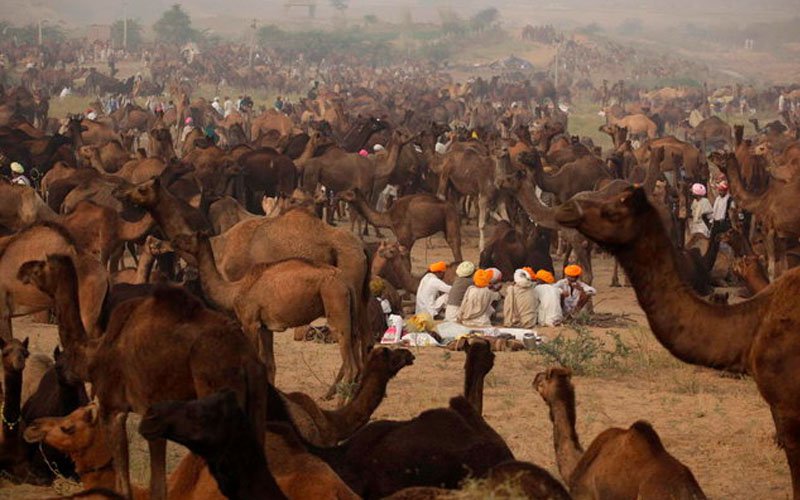
5. Fire-Walking – Theemithi, Tamil Nadu
Fact, they say, is stranger than fiction. The ritual of walking on fire proves it. Originating in Tamil Nadu, the practice of Theemithi has spread to Sri Lanka, Singapore and South Africa as well. Theemithi is part of a larger ceremony stretching over a two-and-a-half month period where parts of the Mahabharata is re-enacted, totalling up to 18 distinguishable rites. The festival of Theemithi is a celebration of Draupadi, wife of the Pandavas. After the Battle of Kurukshetra, Draupadi walked across a bed of fire and emerged as fresh as a flower. Theemithi is a re-enactment of the same, and is believed to grant a wish or blessing by the goddess.
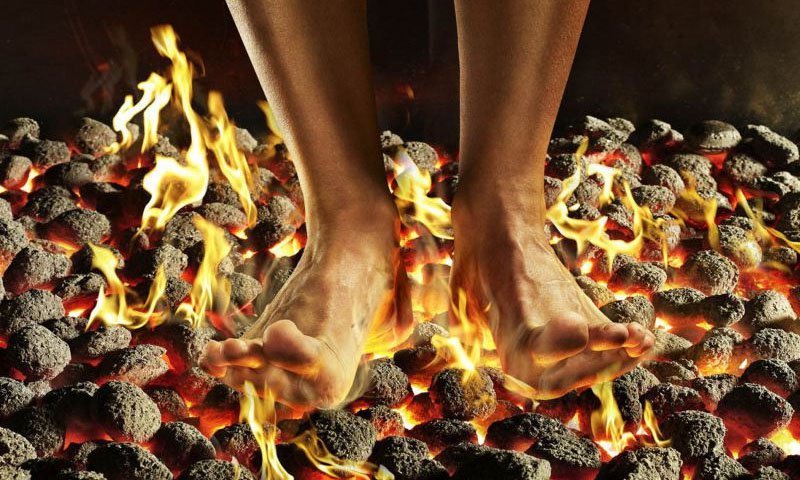
6. Tossing infants from the roof for good luck – Maharashtra and Karnataka
At times, faith takes over our reasoning and makes us do things without ever questioning them. The bizarre practice of baby tossing has been practised in India for years by both, Hindus and Muslims. At Baba Umer Dargah near Sholapur, Maharashtra, babies are dropped from a height of 50 feet, and caught in a sheet held by waiting men. A similar custom is observed at the Sri Santeswar temple near Indi, in the state of Karnataka. This ritual has been followed for over 700 years and is believed to bring prosperity to the family. The National Commission For Protection Of Child Rights is investigating these cases. According to organizers, no injuries have been reported so far.
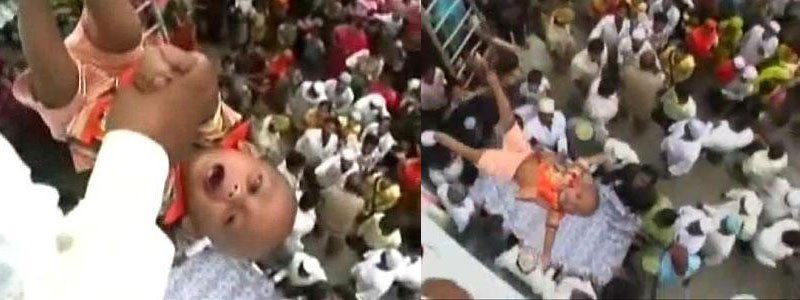
7. Hooking the flesh and piercing the body: Thaipoosam, Tamil Nadu
Faith is a precious ray of light that pulls us out of our inner darkness. The same faith, at times, takes on frightening proportions. Celebrated in Tamil Nadu and parts of southern India during the Tamil month of Thai, Thaipoosam is a festival that honours Lord Murugan (or Kartikeya, the son of Shiva and Parvati) receiving a lance to destroy the evil army of Tarakasura. Following a 48 day fast, many devotees pierce their bodies with hooks, skewers and lances called vel. Some even try pulling tractors or other heavy objects with the hooks in their skin; o thers pierce their tongue and cheek to impede speech and thereby attain full concentration on the Lord. They enter into a trance during such piercing due to the incessant drumming and chanting. The horrifying sight is definitely not for the faint of heart.
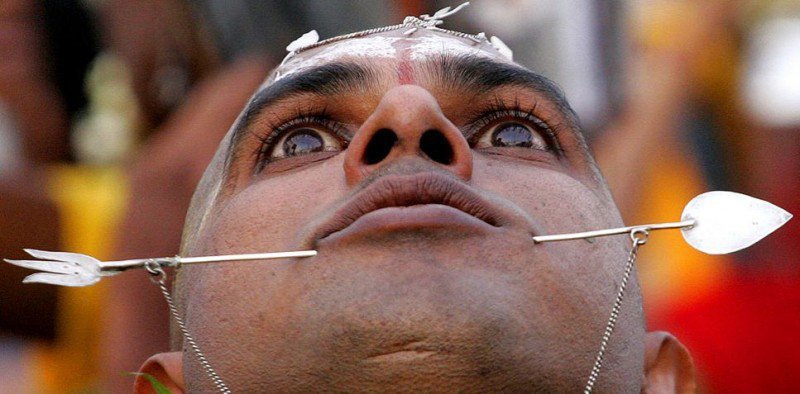
8. Facing the raging bull unarmed – Jallikattu, Tamil Nadu
If Bull-Fighting reminds you of Spanish matadors, think again. A more rustic and dangerous form of the sport has been played in India for over a century now. Jallikattu is a part of Pongal celebrations. Jallikattu bulls are raised wild and special care is taken to feed and exercise them, so they develop into sturdy beasts fit for fighting. Hundreds of men chase the bull, trying to snatch the prize from its horns. Unlike Spanish bull-fighting, the bull isn’t killed in Jallikattu. It is the matador who is left vulnerable, because he cannot carry weapons and the bulls’ horns are sharpened. In the past two decades, over 200 people have died indulging in this dangerous sport. In May 2014, the Supreme Court of India banned Jallikattu.
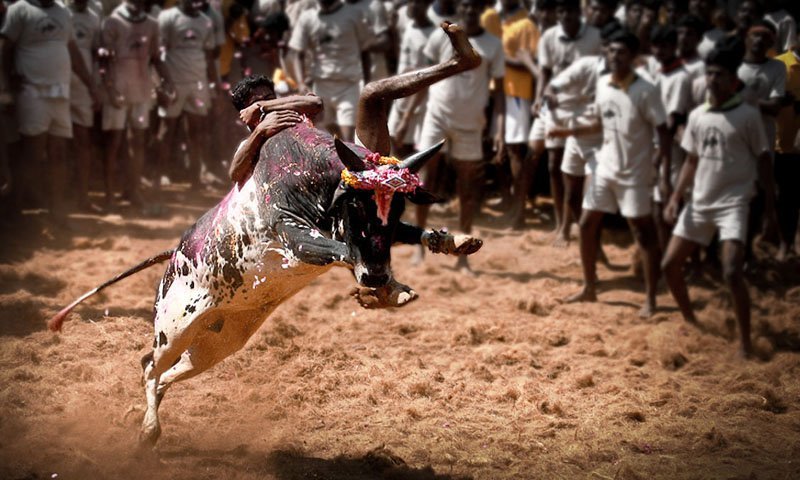
9. Rolling over food leftovers – Madey Snana , Karnataka
Casteism has been one of India’s oldest problems. While the society has changed and condemns such unwarranted discrimination, many still hold on to it. The Kukke Subramania Temple has a strange centuries old tradition called Madey Snana or Spit Bath. Those from lower castes roll on the floor over food leftovers of Brahmins on banana leaves, to rid themselves of various ailments. This practice was banned in 2010, but it had to be lifted in 2011 after protests by the Malekudiya tribe. The ritual has been categorised as a blind belief in the proposed Karnataka Prevention of Superstitious Practices Bill (2013) after progressive leaders and liberals in the state upped their ante against the controversial practice.
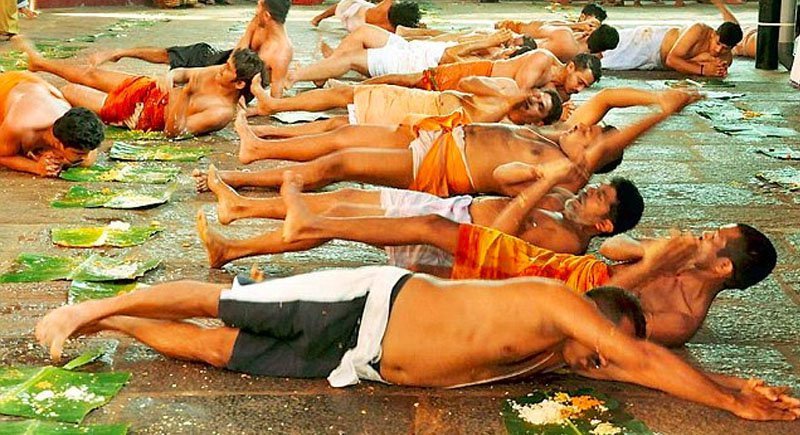
10. Cannibalism and Necromancy – The Aghori way of life, Banaras
The formidable Aghori Sadhus of Banaras are easily recognisable in their long matted hair and bodies smeared in ash. Their way of connecting to God is, very subtly put, off-beat. These monistic saints believe in renouncing the world by finding ‘ purity in the filthiest.’ This leads them to eat human remains after cremation and have intercourse with corpses. They are believed to be posses tantrik powers of healing.
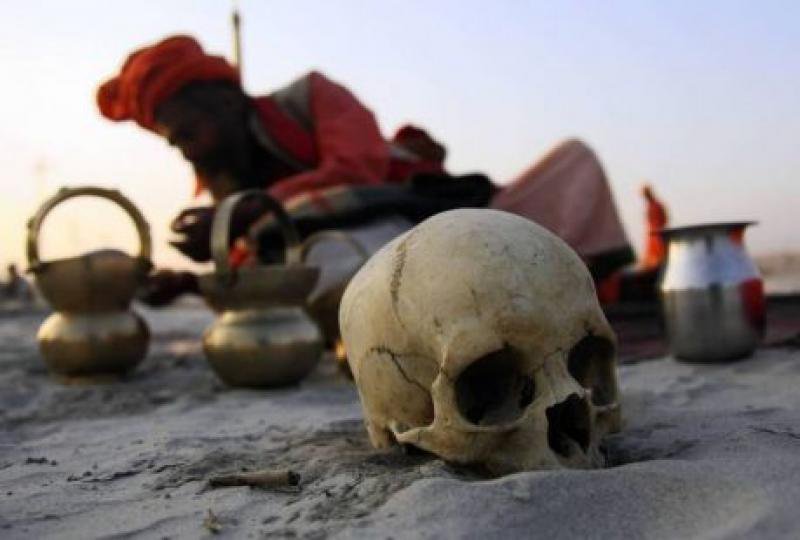
11. Animal Weddings – Appeasing the Rain God
Just as they had shown in Lagaan, rains are a big deal in India. A lot of lives depend on it. No wonder no stone is left unturned to please the rain god into sending his showers of blessings. Frog weddings have been reported in villages across Assam and Maharashtra, while in Karnataka, donkeys are married. Some places have even reported dog weddings. These weddings are a big celebration where all Hindu marriage rituals are observed and the marriage is conducted by a priest.
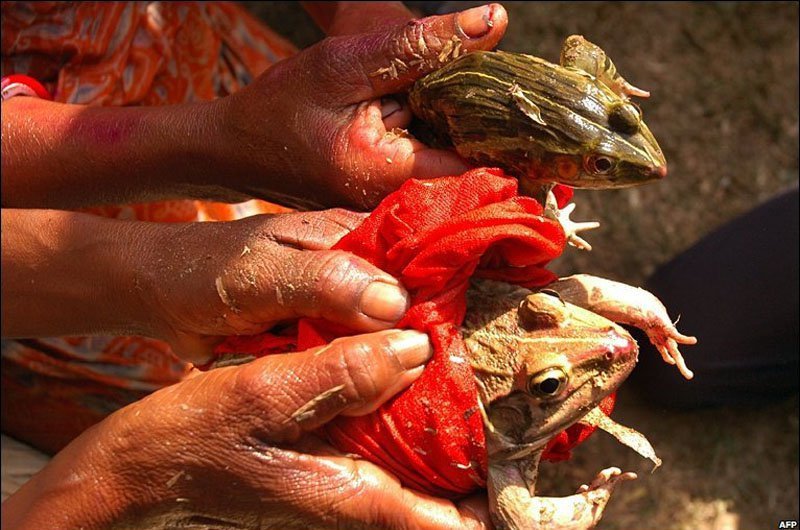
12. Cow Trampling Ritual – Govardhan Puja, Madhya Pradesh
Cows are sacred to the Hindus. This devotion is taken to a whole new level at Bhiwdawad village, in Maharashtra. The Govardhan festival is celebrated on the occasion of Enadakshi, a day after Diwali. Villagers decorate their cattle with flowers, colours and henna, and lay down on the ground letting allowing cows to trample over them! This ritual takes place after a five day fast. The whole village fathers to witness this spectacle, which they believe will move the gods into answering their prayers.
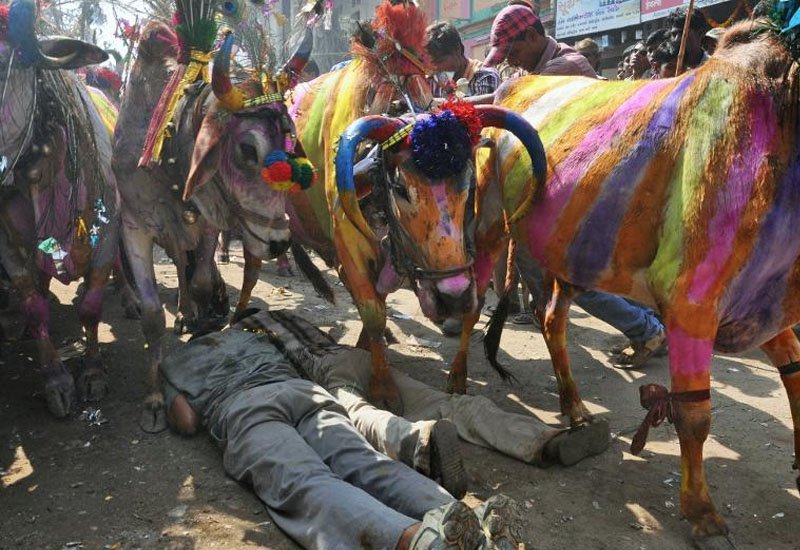
13. Hanging by hooks – Garudan Thookam, Kerala
This ritual art form performed in Kerala’s Kali temples is as fascinating as it as shocking. Dancers dress up as Garuda, the vehicle of Lord Vishnu who quenched the goddess Kali’s thirst with blood after slaying Darika the demon. After the dance performance, they hang like eagles (Garudan Thookam) from a shaft, by hooking the flesh on the backs! These hanging ‘ Garudas ‘ are taken around the city in a colourful procession. This ritual is carried out on Makara Bharani Day and Kumbha Bharani Day.
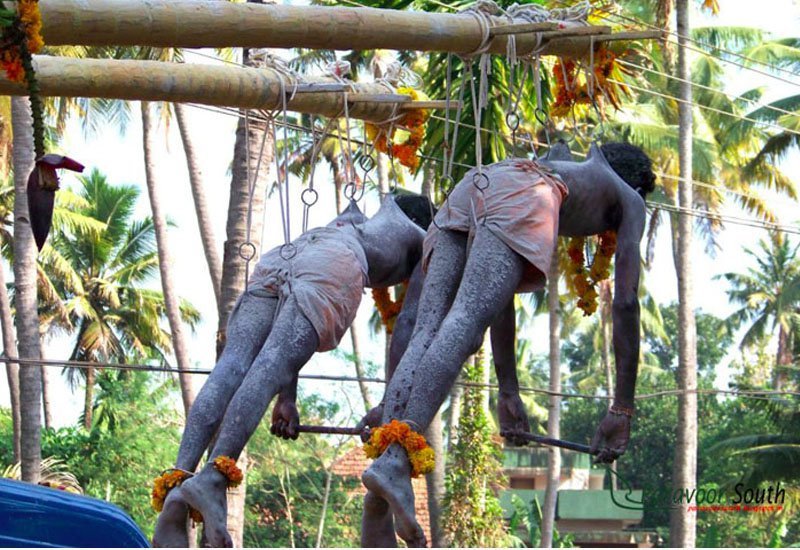
14. Plucking hair out by the hand – Kesh Lochan of Jain saints
Most religions consider Moksha or redemption as the ultimate end of all human endeavours. Ignorance, according to Jains and Buddhists is what stands in the way. In many texts, hair is often read as a metaphor for human illusion, attachment and vanity. Upon their initiation, Jain monks and nuns renounce their worldly attachments by painfully pulling out each strand of hair from their heads. The wounds are then covered in dried cow dung ash to heal.
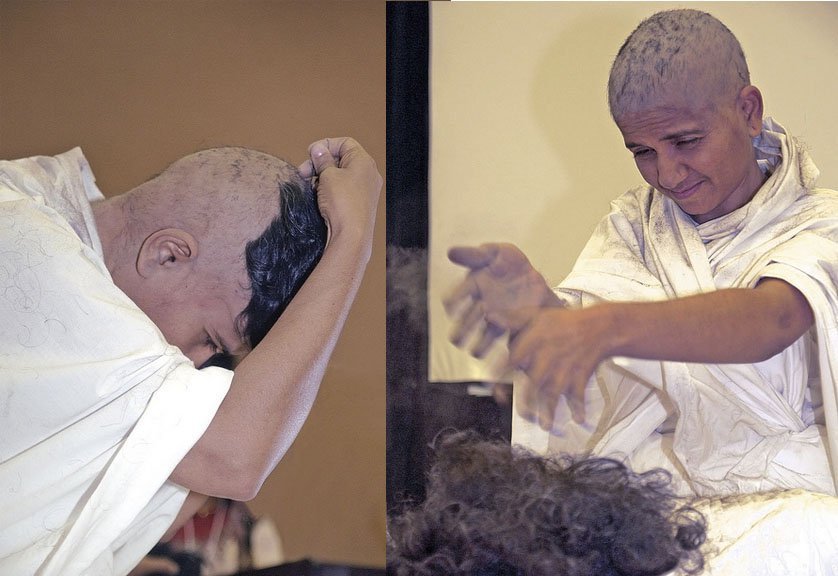
15. Fun by deception – Dhinga Gavar, Jodhpur
At first, the Dhinga Gavar festival may strike you as strange. But then you’ll realize how much fun it might actually be. A part of the Rajasthani Gangaur festival, Dhinga Gavar is only celebrated in Jodhpur. Shiva’s consort, Parvati (Gangaur), had once playfully teased him by dressing up as a tribal woman. Gavar is considered to be the playful side of Gangaur. After sunset, statues of Dhinga Gavar are put up at 11 locations, all decorated with up to 30 kgs of gold! And that isn’t all. Offerings of cannabis are made to the diety! Wait, there’s more. Women take out processions, dressed in all sorts of costumes – Hindu gods and goddesses, police, saints, dacoits and what not – carrying lathis to hit people with and protect the statues! It is a popular belief that any unmarried man who comes near these women and is stricken by the stick gets married soon.
